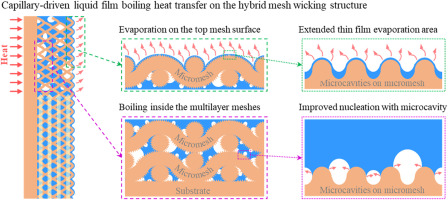Nano Energy ( IF 16.8 ) Pub Date : 2018-06-21 , DOI: 10.1016/j.nanoen.2018.06.063 Rongfu Wen , Shanshan Xu , Yung-Cheng Lee , Ronggui Yang

|
Thermal management of high power electronic systems such as advanced lasers, light emitting diodes, radars, microprocessors, electrical machines, and power inverters, is becoming critical in defense, space, and commercial applications. As a liquid-vapor phase-change process, capillary evaporation on wicking structures has received increased interest owing to its capability dissipating high heat flux by increasing the effective evaporation area and sustaining the liquid supply. However, the approaches based on capillary evaporation suffer from intrinsic tradeoffs between the low thermal resistance for heat flow and the high wicking flow rate for liquid supply, which make it challenging to optimize both heat transfer coefficient (HTC) and critical heat flux (CHF) on the same wicking structure. Here, we present a cost-effective hybrid wicking structure, that can be scalably manufactured using commercial copper micromeshes along with simple etching processes, to enable a novel capillary-driven liquid film boiling heat transfer by simultaneously improving liquid supply and increasing nucleation sites. The interconnected microchannels between woven mesh layers and the substrate serve as low flow resistance passages for high volumetric flow rate of the liquid. Through creating nanograsses and microcavities on the multilayer micromeshes, the liquid flow is enhanced for higher CHF due to the increased surface wettability. Moreover, a plural of microcavities on the mesh surface decrease the superheat for early onset of nucleate boiling (ONB), resulting in higher HTC. Enhanced CHF (198.6 W/cm2) and HTC (138.7 kW/m2 K) are observed on the hybrid mesh wicking structure with a 10 mm × 10 mm heated area due to more than twice the flow rate for liquid supply and more than one third reduced superheat at the ONB, compared to that on the plain mesh wicking structure. The insights gained from this study can be used to guide the design and manufacturing of highly efficient wicking structures in heat pipes, vapor chambers, and other high flux thermal systems.
中文翻译:

混合网格芯吸结构上的毛细管驱动液膜沸腾换热
高功率电子系统(例如高级激光器,发光二极管,雷达,微处理器,电机和功率逆变器)的热管理在国防,太空和商业应用中变得至关重要。作为液体-蒸汽相变过程,由于其能够通过增加有效蒸发面积并维持液体供应来消散高热通量,因此在毛细作用结构上的毛细管蒸发受到了越来越多的关注。然而,基于毛细管蒸发的方法在热流的低热阻和液体供应的高毛细流率之间存在固有的权衡,这使得同时优化传热系数(HTC)和临界热通量(CHF)面临挑战。在相同的芯吸结构上。这里,我们提出了一种具有成本效益的混合芯吸结构,可以使用商业铜微网和简单的蚀刻工艺来规模化制造这种芯吸结构,以通过同时改善液体供应和增加成核位点来实现新型的毛细管驱动液膜沸腾传热。编织的网状层和基底之间的互连的微通道用作液体的高体积流率的低流阻通道。通过在多层微孔上形成纳米草和微腔,由于增加了表面可湿性,从而提高了液体流量以提高CHF。此外,网孔表面上的多个微腔减少了过热,从而使核沸腾(ONB)提前开始,从而导致更高的HTC。增强的CHF(198.6 W / cm 可以使用商品化的铜微网以及简单的蚀刻工艺来大规模生产这种产品,以通过同时改善液体供应和增加成核位点来实现新型的毛细管驱动液膜沸腾传热。编织的网状层和基底之间的互连的微通道用作液体的高体积流率的低流阻通道。通过在多层微孔上形成纳米草和微腔,由于增加了表面可湿性,从而提高了液体流量以提高CHF。此外,网孔表面上的多个微腔减少了过热,从而使核沸腾(ONB)提前开始,从而导致更高的HTC。增强的CHF(198.6 W / cm 可以使用商品化的铜微网以及简单的蚀刻工艺来大规模生产这种产品,以通过同时改善液体供应和增加成核位点来实现新型的毛细管驱动液膜沸腾传热。编织的网状层和基底之间的互连的微通道用作液体的高体积流率的低流阻通道。通过在多层微孔上形成纳米草和微腔,由于增加了表面可湿性,从而提高了液体流量以提高CHF。此外,网孔表面上的多个微腔减少了过热,从而使核沸腾(ONB)提前开始,从而导致更高的HTC。增强的CHF(198.6 W / cm 通过同时改善液体供应和增加成核位点来实现新型的毛细管驱动液膜沸腾传热。编织的网状层和基底之间的互连的微通道用作液体的高体积流率的低流阻通道。通过在多层微孔上形成纳米草和微腔,由于增加了表面可湿性,从而提高了液体流量以提高CHF。此外,网孔表面上的多个微腔减少了过热,从而使核沸腾(ONB)提前开始,从而导致更高的HTC。增强的CHF(198.6 W / cm 通过同时改善液体供应和增加成核位点来实现新型的毛细管驱动液膜沸腾传热。编织的网状层和基底之间的互连的微通道用作液体的高体积流率的低流阻通道。通过在多层微孔上形成纳米草和微腔,由于增加了表面可湿性,从而提高了液体流量以提高CHF。此外,网孔表面上的多个微腔减少了过热,从而使核沸腾(ONB)提前开始,从而导致更高的HTC。增强的CHF(198.6 W / cm 编织的网状层和基底之间的互连的微通道用作液体的高体积流率的低流阻通道。通过在多层微孔上形成纳米草和微腔,由于增加了表面可湿性,从而提高了液体流量以提高CHF。此外,网孔表面上的多个微腔减少了过热,从而使核沸腾(ONB)提前开始,从而导致更高的HTC。增强的CHF(198.6 W / cm 编织的网状层和基底之间的互连的微通道用作液体的高体积流率的低流阻通道。通过在多层微孔上形成纳米草和微腔,由于增加了表面可湿性,从而提高了液体流量以提高CHF。此外,网孔表面上的多个微腔减少了过热,从而使核沸腾(ONB)提前开始,从而导致更高的HTC。增强的CHF(198.6 W / cm2)和HTC(138.7 kW / m 2 K)在加热面积为10 mm×10 mm的混合网状芯吸结构上观察到,这是因为液体供应流量的两倍以上,ONB处的过热减少了三分之一以上,与普通网状芯吸结构相比。从这项研究中获得的见解可用于指导热管,蒸气室和其他高通量热系统中高效芯吸结构的设计和制造。











































 京公网安备 11010802027423号
京公网安备 11010802027423号